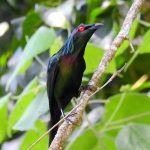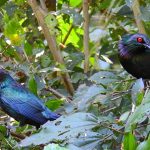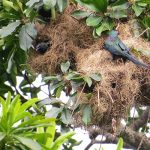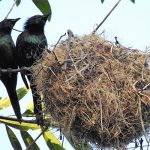METALLIC STARLING
Sharon: Headed off for some camping on Cape York in Northern Queensland, Australia, to see what we could find. We camped beachfront at Chilli Beach in Iron Range National Park for a few wonderful days. The water was still, and the winds were calm and the Metallic Starling’s had arrived. So, we were in for a treat. Each afternoon the Metallic Starlings would ‘flock up’ together and fly to the tiny island that was just offshore from the beach. Their safe overnight roosting site. The ‘Close Encounter’ we saw was amazing – It was a ‘Murmuration‘ of birds. That was a ‘Wow’ moment.
The Metallic Starling: A Jewel of the Rainforest
Imagine standing at the edge of a lush, sun-dappled rainforest in northern Queensland. The air is warm and humid, filled with the scent of damp earth and the gentle rustle of leaves overhead. Suddenly, a flash of iridescent green, blue, and purple darts through the canopy—a Metallic Starling, its glossy feathers shimmering as it catches the light, a living jewel against the verdant backdrop.
Appearance and Distinctive Features
The Metallic Starling is a true spectacle of nature. Its most striking feature is its glossed, metallic plumage, which shifts in hue depending on the angle of the sunlight—radiating greens, blues, and purples that seem almost otherworldly. Contrasting this brilliance are its vivid red eyes, which gleam with intensity, and its sleek black beak and legs, completing a look that is both elegant and unmistakable.
Habitat and Distribution
- Native Range: Moluccas, New Guinea, Queensland (Australia), Solomon Islands
- Australian Stronghold: Tropical rainforests of northern Queensland
- Migration: Some populations journey to New Guinea and nearby islands during the non-breeding season
Within these rainforests, the Metallic Starling thrives amidst towering trees, dense foliage, and an orchestra of wildlife sounds. The rich scent of ripe fruit and the cool, moist undergrowth define their home.
Behaviour and Social Structure
- Vocalisations: An array of calls—whistles, chirps, and squawks—echo through their habitat, creating a lively soundscape.
- Flocking: Highly social, Metallic Starlings often gather in large, bustling flocks, especially around fruiting trees.
Imagine the sensation of standing beneath a tree alive with their chatter, the air vibrating with their varied vocalisations—a multi-sensory experience that highlights their social nature.
Diet and Ecological Role
- Primary Diet: Frugivorous, with a strong preference for figs and other soft fruits
- Occasional Insects: During breeding, they supplement their diet with insects to provide essential protein for their chicks
The Importance of Seed Dispersal
By consuming fruit and later excreting the seeds, Metallic Starlings play a vital role in the propagation of many rainforest plants. Each meal is an act of renewal, helping to sustain the intricate web of life that characterises their home.
| Diet Component | Importance |
|---|---|
| Fruit | Energy and seed dispersal |
| Insects | Protein for growing chicks |
Nesting and Reproduction
- Lifespan: Typically 4 to 5 years, sometimes longer under ideal conditions
- Breeding Season: September to March
- Nest Structure: Intricately woven from grasses and plant fibres, suspended from tall branches
- Communal Nesting: Multiple pairs nest closely in a single tree, forming vibrant nesting colonies
- Eggs: 2–4 per clutch, incubated by both parents for about 14 days
- Chick Rearing: Both parents feed the chicks until they fledge
Envision a single tree transformed into a bustling neighbourhood—each nest a carefully crafted cradle, the air filled with the gentle flutter of wings and the quiet peeping of chicks.
Conservation Message
While the Metallic Starling is not currently endangered, its presence highlights the delicate balance within rainforest ecosystems. These birds are more than just beautiful visitors; they are essential participants in the health and regeneration of their environment.
Why Conservation Matters
- Habitat Protection: Safeguarding rainforests ensures survival for Metallic Starlings and countless other species.
- Sustainable Practices: Supporting eco-friendly initiatives helps preserve the intricate relationships within these habitats.
- Biodiversity: Each species, no matter how small, contributes to the resilience and richness of our planet.
Conclusion
The story of the Metallic Starling is a reminder of nature’s artistry and interconnectedness. Their iridescent feathers, lively calls, and social communities create a tapestry of life that enriches the rainforests of northern Australia and beyond. By valuing and protecting these birds and their habitats, we ensure that future generations can experience the wonder and beauty that the Metallic Starling represents.
Let us all be inspired to cherish and protect the living treasures of our world.
Did you know?
Metallic Starlings often return to the same nesting trees year after year, creating family colonies that can last for generations.
For more stories about Australian wildlife and how you can help protect them, consider exploring local conservation programs or supporting sustainable rainforest initiatives.




